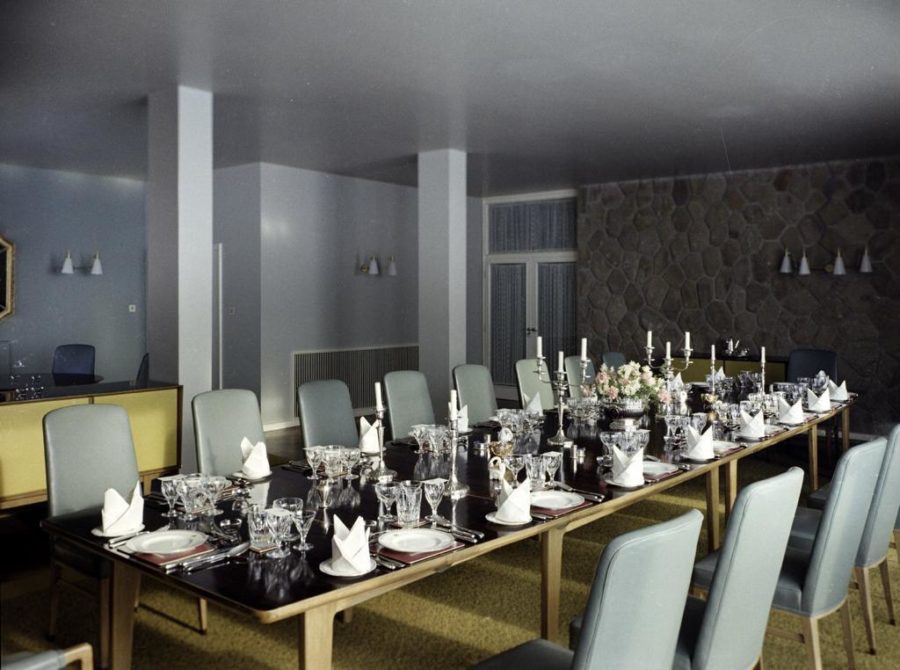UK Ambassador to Serbia
Part of UK in Serbia
30th October 2020 Belgrade, Serbia
A House in Dedinje 
Diplomats move house more than most people. We move between countries every two, three or four years. We move backwards and forwards to and from our own countries. Even within our home countries jobs in our foreign ministries may be spread across more than one city.
I have lived in six countries outside the UK. Some of my colleagues will have lived and worked in even more.
Some countries expect their diplomats to take their own furniture with them as they move around the world. British diplomats don’t do this – and haven’t done so for very many years. That makes it easier when it comes to moving. But it also means you spend most of your working life living with furniture and furnishings, and in houses, that aren’t your own.
(It also means that when you walk into a British diplomat’s house or flat anywhere in the world you are quite likely to recognise your own tables and chairs.)
Ambassadors’ Residences are a bit different. We do also move into furnished houses, but the furniture and furnishings are not just intended to serve as a family home.
The curtains and the pictures are not there just to please the people who live in the house, but also to say something about the country they represent.
The chairs are not just for sitting on – or even just to withstand the wear of hundreds or thousands of visitors each year.
Often the furnishings will match the age and architecture of the building – sometimes because they have been there for several hundred years. (In Prague we lived with one wonderful, antique cupboard that was probably too big and too heavy ever to have moved for about 400 years.)
Everything about an ambassador’s residence gives an impression of their country and the image it wants to project abroad. For the UK I would say that the effect is usually a blend of traditional and contemporary design, reasonably stylish but also practical, smart but not unduly luxurious or extravagant. A bit like the UK in other words.
All Residences also reflect the personalities and interest of their temporary occupants – the current Ambassador and their family. The permanent official furnishings are overlaid by their interests, their books, their photos, and their souvenirs from previous postings. Although a Residence is a working building it is, after all, also a home not a museum, and it takes on the character of the people living in it, albeit temporarily.
Every so often an ambassador will have the chance to arrange some redecoration or to replace some of broken or worn out furniture. But we always have to do so with a keen eye on value for public money.
In past days the change might be more extensive. One distinguished British diplomat wrote:
‘The new ambassador’s wife inevitably had different tastes from her predecessor’s…the reproduction regency chairs go back into the store-room…..with the next incumbent the process is reversed.’ (Humphrey Trevelyan, Diplomatic Channels).
British ambassadorial residences around the world range from small family houses, or flats located inside a small embassy, to some truly magnificent historic buildings.
Modern public finances and economics mean that around the world we have sold or given up some of our larger residences and replaced them with more modest, practical accommodation. In Vienna for example I lived in a city flat, within cycling distance of the office, rather than in a romantic villa surrounded by vineyards like some of my predecessors.
There is very good reason though for maintaining some of our larger, historic buildings.
An Embassy historically was where an ambassador lived and worked – and their diplomatic staff were squeezed into any available space around the edges to work and sometimes also to live.
This was the case when I worked in our beautiful old Moscow Embassy in the 1980s. It still is the case in Prague where I, like my predecessors and successors, lived ‘above the shop’, sharing our family home – a beautiful historic building – with a full working Embassy and a few thousand guests every year.
It was also the case when our Belgrade Embassy – then known as a Legation – was built in the 1930s. This building replaced a series of rented locations around the city where having the Defence and Commercial sections next to the head of mission’s bedroom proved inconvenient for all concerned.
The British Government only decided though to build a separate Belgrade Residence in 1959 when the Embassy outgrew the available space.
We have President Tito to thank for the location of that new Residence, just a stone’s throw from his own Belgrade home.
I feel very lucky to live in this house, located in the city’s greenest suburb, purpose built in 1959, and thoroughly ‘liveable’. It still feels bright and modern, rather like a scaled up version of a typical late 1950s family house in the British suburbs.
Not all my predecessors have agreed. One referred to it disparagingly as a 1960s bungalow. Another wrote in 1977:
Anyone who strips the wallpaper and plaster from the dining room and goes back to the stone work will find they have reverted to something looking exactly like the dining area of a Yugoslav Youth Hostel.
He went on:
The Queen’s State visit in 1972 fortunately allowed a complete transformation…..
Oh well, tastes and fashions change. I love the house in Dedinje with its big windows, curving staircase and wooden floors. I am rather sad that the original mid-century modern furniture seems to have been lost with that 1970s makeover.
Acting as temporary guardian for a historic building that is something between a museum, a hotel, a restaurant and a family home, whilst ensuring that it fulfils its intended role, is not the most visible aspect of an ambassador’s job. But it is still an important responsibility and, as diplomats love learning about new things, you can also get to learn quite a lot about architectural and design history.
Fortunately, Foreign Office historians have kept an impressive series of photographs chronicling our Residence over the past decades. So when our turn came to repaint after structural building works, and replace some chairs and curtains, we were able to look at photographs showing the Residence in its understated 1950s elegance and to copy some of its original colours and style.
I particularly like a photo of the dining room showing ultra modern 50s styling combined with very traditional table ware – and that lovely stone ’youth hostel’ wall.
It’s all a question of taste though….when I leave in three years’ time who knows what my successor will think of our lovely lime green walls?
The house is a few years older than me, but I feel that we are of the same generation.
Originally built with a film projection room – it is contemporary with Our Man in Havana starring Alec Guinness, and publication of Ian Fleming’s Goldfinger. I like to think that diplomatic decorum and protocol allowed my 1960s predecessors to fill these rooms with guests dancing the night away to the sound of the Beatles.
Our Belgrade Residence is also contemporary with the Palace of Serbia, the vast building where all newly arrived ambassadors present their credentials to the President. I’d be surprised if any other diplomat in Belgrade takes quite so much interest in its classic, historicfurniture.
Over the past, difficult, coronavirus months I have felt that incredibly lucky that ‘working from home’ for me means looking out of these big windows at the birds and the trees in our garden and the woodland on the edge of the city.
I look forward to filling the house and garden with guests again once times are easier. In the meantime we will be making sure that we look after the House in Dedinje well for future diplomatic generations.
The post A House in Dedinje appeared on BIDD.








